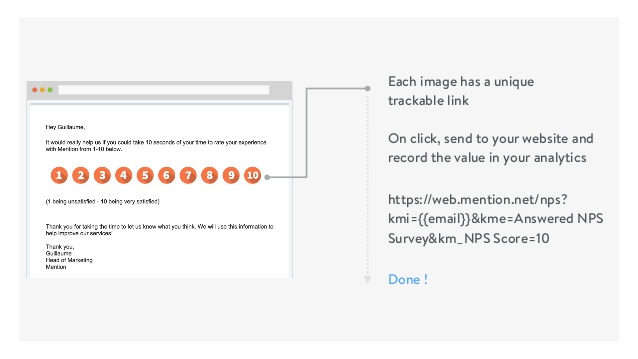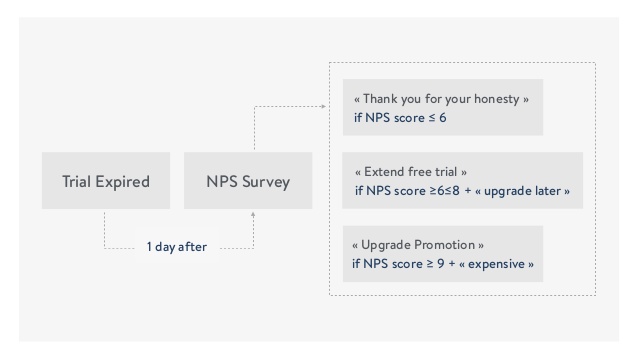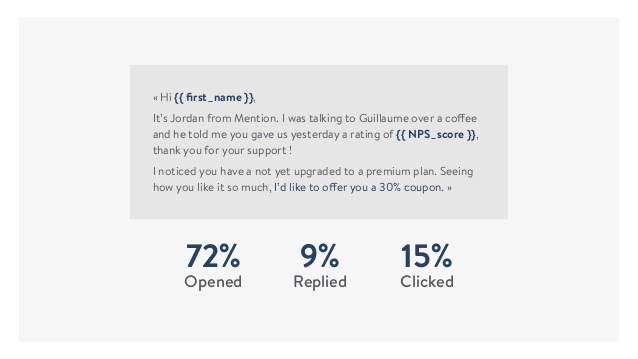Based on their responses, customers are categorized into one of three groups:
- Promoters (9-10 rating),
- Passives (7-8 rating),
- Detractors (1-6 rating).
Subtracting the total number of detractors from the total number of promoters provides a “net promoter” score and this score is used as an estimate of customer loyalty and business growth.
Despite its merits, NPS has had its fair share of criticism, largely because it takes measurements based on a customer’s attitude rather than behavior.
As such it can only reflect present intention, not future actions. In other words, NPS tells us how people feel about us, not how they will act on this feeling.
The experiment by Guillaume Cabane @Mention
One way to see how people will act based on how they feel about your products and services is to ask them to take that action and yes, that sounds incredibly obvious, but there haven’t been many practical examples of this, until recently.
Thanks to Guillaume Cabane we now have a very practical and well documented example of how this advice can be implemented:
Here’s what Guillaume did:
1. Send the NPS email
One day after their free trial for Mention ended, users were sent the NPS email asking them to rate their experience with Mention on a scale of 1 to 10.
Here’s what that email looked like:

Guillaume tried multiple setups for the whole process to automate as much of it as possible. In the final setup, the NPS score was collected using a dedicated service called SatisMeter. Of course you can use any customer feedback tool you already work with.
2. Act based on answers
After users had given their answers, based on the score they gave to Mention, they were targeted with a specific email.

Although the emails were automated, they were made to look like they were sent manually by the Mention staff:

3. It works. Time to do it all over again!
NPS is a great way to see how people feel about you. When you act based on a user’s feelings about your company, you personalize the experience for that user and get great results.
Guillaume and his team, having experienced this for themselves, decided to take the project a step further.
They started targeting paying customers with NPS, to get a sense of how these customers were feeling about Mention, and then used that data in targeted messages.
The goal this time? Decrease churn. And it worked!

What can we learn from this experiment?
We already know that NPS is a great way to find out how your users feel about your product or service but, as the critics are all too quick to remind us, how they feel does not equal how they will act.
If they say that they are very likely to recommend your product to a friend, it doesn’t mean that they will. It simply means that they like your product very much.
Targeting users with personalized messages based on their feelings can be a great way to have them act on those feelings and drive growth. It can work at any point in the product cycle, with both new and existing users.
The tools you’ll need to run this experiment for yourself.
These are the things you’ll need to run this experiment within your company. In case you’re champing at the bit to get started, we’ve included the specific tools Mention used. There will of course be other, comparable products, which you may prefer.
Customer.io
A platform for sending targeted messages.
SatisMeter
A platform that helps you gather customer feedback using the Net Promoter® System.
Zapier
A service for synchronizing the data between the other platforms used in this experiment.
HelpScout
A help or support desk to manually follow up with users based on their score.
Segment
A service hub for collecting user analytics data and sending it to different analytics providers.
Ready to Experiment?
Here at InnerTrends, we love experiments! But, what use is a good experiment if you don’t then learn from it and use what you’ve learned to impact the growth and development of your own company?
So, tell us in the comments, what’s the very next action you’re going to take based on what you’ve learned today?
Biography
- Improving the Predictive Validity of NPS in Customer Satisfaction Surveys (Volume 8528 of the series Lecture Notes in Computer Science pp 458-469) http://link.springer.com/chapter/10.1007/978-3-319-07308-8_44
- Mention’s Slideshare presentation for their NPS project: http://www.slideshare.net/mentionapp/mention-nps-process-reduce-churn-increase-customer-hapiness
Looking for deep insights into how your customers use your product?
InnerTrends can help. You won’t have to be a data scientist to discover the best growth opportunities for your business, our software will take care of that for you.
Schedule a Demo with us and witness with your own eyes just how powerful InnerTrends can be.